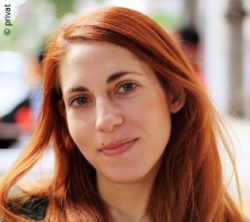Interview with Prof. Vasiliki Giagka, Group Leader “Technologies of Bioelectronics”, Fraunhofer Institute for Reliability and Microintegration IZM and Assistant Professor of Bioelectronics, Delft University of Technology
In MEDICA Magazine, 23.11.2020
Active implants such as pacemakers revolutionized healthcare decades ago. But they also have disadvantages: their size and relatively short life span, for example. At Fraunhofer IZM, research is therefore being conducted on durable microimplants that stimulate nerve cells electrically in a targeted manner and are even to be used to treat multiple sclerosis.

Prof. Vasiliki Giagka
In an interview with MEDICA-tradefair.com Prof. Vasiliki Giagka talks about how microimplants work, why they are an alternative to drug therapies and how they could help paraplegics.
Prof. Giagka, you have developed a microimplant for stimulating nerve cells. Can you tell us more about it?
Prof. Vasiliki Giagka: My team and I are developing bioelectronic implants that interact with the body. Their predecessor is the pacemaker, which was developed as early as 1958. However, our implants interface with the nervous system and artificially stimulate it. But this is nothing new either. Cochlear implants or implants for deep brain stimulation work in the same way. These implants contain electronics that generate the stimulating impulses and are normally located inside a rather large hermetic case from which a long wire comes out. At the tip of the wire is an electrode that is placed near the part of the body that needs to be stimulated.
Our goal is now to develop particularly small implants – so-called microimplants. These can be placed near the organs or nerves that are to be targeted. There, small electrical impulses stimulate the nerve tissue.
What are the advantages over other implants or therapies?
Giagka: The difference to previous bioelectronic implants is that everything is contained in a single small unibody implant or node. We do not have the distributed arrangement of having the case at one point, the electrode at another point and a long wire that connects the two together. This makes them minimally invasive. They can also be operated in a network. Several of them can therefore be placed on the specific nerve or at different locations in the body and communicate with each other, exchange information and thus adapt the therapy. The doctor is also able to adjust the therapy wirelessly.
We would like to develop an alternative to conventional pharmaceuticals. A neuronal signal is transmitted in the body via either electrical or chemical pathways. Conventional drugs intervene in the chemical pathways. We are trying to intervene in the electrical pathways to enable a therapy that can be adjusted similar to a drug therapy, but without side effects. Drugs have side effects because they act on the whole body. But a therapy with a microimplant is local, reversible and free of side effects. This is also referred to as electroceuticals or bioelectronic medicines.

For which diseases can such an implant be used?
Giagka: One of the most prominent applications is to reduce inflammation. For this reason, bioelectronic medicine is also used to treat diseases that we have not yet addressed. These include autoimmune diseases such as multiple sclerosis and rheumatoid arthritis. There are studies that show that the cellular inflammation caused by these diseases can be reduced daily by applying electrical impulses in limited doses.
What are your next goals in the further development of the implant?
Giagka: We are focusing on three goals: The first is the miniaturization of implants. The second is longevity. After all, we are talking about implants that will probably have to remain in the body for decades. This is no trivial matter. At the moment we cannot even test for that long. The third goal is specificity or selectivity. This means that the implants must be able to target smaller structures in the body more precisely. So far, the electric field stimulates everything in its vicinity. We are pursuing the goal of being able to stimulate individual nerves in a targeted manner.
What could be possible in the future with such microimplants?
Giagka: In addition to the applications already mentioned, there are other diseases that could be treated with such technologies. During my doctoral thesis, I conducted research on implants for the spinal cord, which aim to restore the mobility of people paralyzed by a spinal cord injury. But all these applications will only be possible if we have a better understanding of the nervous system. A better understanding of the nervous system and the signal transmission in our body is the way to tailor-made therapies. Once we know which nerve or nerve cell produces the desired effect, we can interfere with that nerve or nerve cell. We have to create specific tools for this. We could treat diseases that were previously untreatable, and we could better control and target therapies – that is very exciting!

MEDICA-tradefair.com












